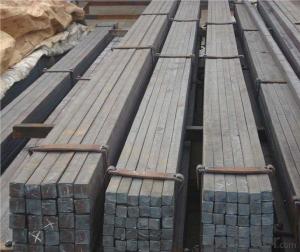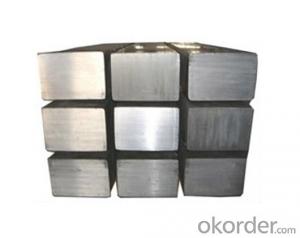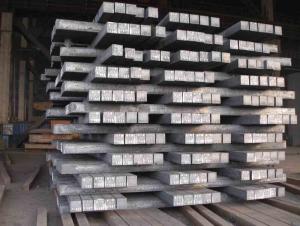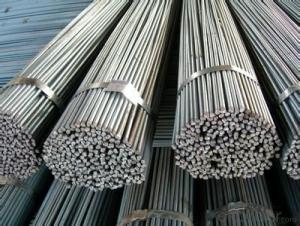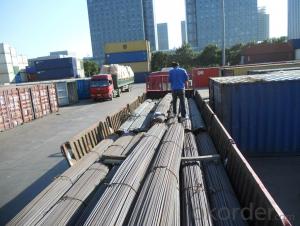Steel Square Bar High Quality 5mm-100mm Q195 or Q235
- Loading Port:
- Shanghai
- Payment Terms:
- TT or LC
- Min Order Qty:
- 50 m.t.
- Supply Capability:
- 20000 m.t./month
OKorder Service Pledge
OKorder Financial Service
You Might Also Like
Product Description:
OKorder is offering High Quality Square Bar 5mm-100mm Q195 or Q235 at great prices with worldwide shipping. Our supplier is a world-class manufacturer of steel, with our products utilized the world over. OKorder annually supplies products to European, North American and Asian markets. We provide quotations within 24 hours of receiving an inquiry and guarantee competitive prices.
Product Applications:
1) Suitable for making various strong cutting tool abrasion resistance, impact resistance.
2) Used to produce all kinds of high hard and super hard saw blade, drill, tap, broach, gear hob and various kinds of milling cutter.
3) Used for advanced punching die, screw die, and the toughness and complicated shape of the punch, etc.
4) Is used for cold forging die and drawing mode, etc.
5) Recommended watchcase factory, screw factory and other cold stamping products industry use.
Product Advantages:
OKorder's High Quality Square Bar 5mm-100mm Q195 or Q235 are durable, strong, and resist corrosion.
Main Product Features:
· Premium quality
· Prompt delivery & seaworthy packing (30 days after receiving deposit)
· Corrosion resistance
· Can be recycled and reused
· Mill test certification
· Professional Service
· Competitive pricing
Product Specifications:
Standard: GB,
-Grade: Q195 or equivalent.
-Chemical Composition:
Standard | Grade | Element (%) | ||||
GB | Q195 | C | Mn | S | P | Si |
0.06~0.12 | 0.25~0.50 | ≤0.050 | ≤0.045 | ≤0.30 | ||
Measures of HR Square Bar (small measures):
-Length of a side and Theoretical weight of Square Bar.
Length of a side(mm) | Theoretical weight(kg/m) | Length of a side(mm) | Theoretical weight(kg/m) |
7 | 0.385 | 22 | 3.80 |
8 | 0.502 | 24 | 4.52 |
9 | 0.636 | 25 | 4.91 |
10 | 0.785 | 26 | 5.30 |
11 | 0.950 | 28 | 6.15 |
12 | 1.13 | 30 | 7.06 |
13 | 1.33 | 32 | 8.04 |
14 | 1.54 | 34 | 9.07 |
15 | 1.77 | 36 | 10.17 |
16 | 2.01 | 38 | 11.24 |
17 | 2.27 | 40 | 12.56 |
18 | 2.54 | 42 | 13.85 |
19 | 2.82 | 45 | 15.90 |
20 | 3.14 | 48 | 18.09 |
21 | 3.46 | 50 | 19.63 |
Notes:
1, The theoretical weights in the list, base on the density of 7.85 g/cm3.
2, Formula for theoretical weight of Square bar: (length of a side)2 * 0.00785
3, The numbers with *mean that they are not regular or we don’t offer them.
-Regular length of Square Bar:
Steel | Length of a side (mm) | Length of steel (m) |
Normal steel | < 25 | 4~10 |
> 25 | 3~9 | |
Steel of high quality | All measure | 2~6 |
Tool steel >75 | 1~6 |
FAQ:
Q1: Why buy Materials & Equipment from OKorder.com?
A1: All products offered byOKorder.com are carefully selected from China's most reliable manufacturing enterprises. Through its ISO certifications, OKorder.com adheres to the highest standards and a commitment to supply chain safety and customer satisfaction.
Q2: How do you package the angle steel when shipping?
A2: All goods are packed in bundles with steel strips and shipped by container or break bulk.
Q3: The products are invoicing on theoritical weight or on actual weight?
A3: We can do it in both manners, according to the customers' request.

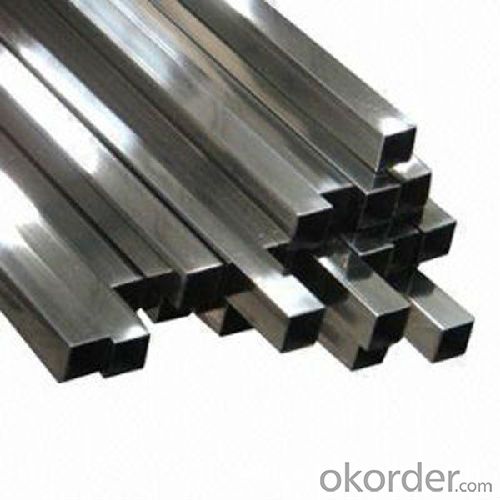
- Q:How do you use a steel square to determine the angle of a dado groove cut?
- To determine the angle of a dado groove cut using a steel square, the following steps should be followed: 1. Begin by setting up the workpiece and ensuring it is securely in place, leveled, and stable. 2. Position the steel square along the edge of the workpiece, aligning one side of the square with the wood's surface. 3. Identify the side of the steel square that contains angle markings, typically located on the longer side. 4. Locate the angle measurement that corresponds to the desired angle of the dado groove cut. For example, if a 45-degree angle is desired, find the marking indicating 45 degrees. 5. Align the identified angle marking with the edge of the workpiece. 6. Securely hold the steel square in position, ensuring it remains stable and doesn't shift during the next step. 7. Using a pencil or marking knife, trace along the edge of the steel square, marking the line where the dado groove cut will be made. This line represents the desired angle determined by the steel square. 8. Verify the alignment of the steel square and the marked line to ensure accuracy. 9. Finally, proceed to make the dado groove cut along the marked line using appropriate tools such as a dado blade on a table saw or a router with a straight bit. Remember to maintain a steady hand and adhere to all safety precautions when utilizing power tools. Always wear suitable safety gear and follow the manufacturer's instructions for the specific tools employed.
- Q:How do you use a steel square to measure and mark 157.5-degree angles?
- In order to measure and mark a 157.5-degree angle using a steel square, the following steps can be followed: 1. Begin by aligning the short side of the steel square with the desired material or surface's edge where the angle needs to be marked. 2. Rotate the square until the long side is aligned with one of the reference points or edges on the material. This reference point can either be an existing line or a corner. 3. Identify the 45-degree angle on the steel square, typically indicated by a small notch or line. 4. Proceed by adding another 45 degrees in the same direction from the 45-degree angle. This will result in a 90-degree angle. 5. Continue by adding another 45 degrees in the same direction from the 90-degree angle. This will result in a 135-degree angle. 6. Lastly, add another 22.5 degrees in the same direction from the 135-degree angle, bringing the total to 157.5 degrees. 7. With the steel square properly positioned, create a small mark or draw a line to indicate the desired 157.5-degree angle. It is important to keep in mind that steel squares typically have limited degree markings, usually up to 45 degrees or 90 degrees. For measuring angles beyond these limits, multiple angles or other measuring tools like a protractor or bevel gauge must be utilized.
- Q:Can a steel square be used for determining the correct depth of a dado cut?
- Determining the correct depth of a dado cut can be achieved with the use of a steel square. In woodworking and carpentry, a steel square is a versatile tool that is frequently utilized. Its right angle shape, accompanied by a ruler on one side, makes it ideal for accurately measuring and marking angles and distances. To utilize a steel square for determining the correct depth of a dado cut, the following steps can be followed: 1. Utilize a ruler or tape measure to measure the desired depth of the dado cut on the material's edge. 2. Position the steel square vertically against the material's surface, ensuring that the ruler aligns with the measured depth mark. 3. Securely hold the steel square in place, guaranteeing that it is perpendicular to the material's surface. 4. Employ a pencil or marking knife to trace along the steel square's edge, creating a visible line that represents the accurate depth of the dado cut. By employing a steel square, both accuracy and consistency in the depth of your dado cut can be ensured. This tool offers a reliable and straightforward approach to achieving precise measurements in woodworking projects.
- Q:How does a steel square assist in determining the correct angle for a sliding dovetail joint?
- A steel square can be used to ensure the correct angle for a sliding dovetail joint by providing a precise and accurate measurement tool. By placing the steel square against the edges of the joint and adjusting it until it aligns perfectly, one can determine the correct angle needed for a tight and secure fit.
- Q:How do you use a steel square to determine the slope of a deck?
- To find the slope of a deck using a steel square, you can proceed as follows: 1. Locate a flat and level surface near the deck, such as the ground or a nearby table. 2. Place the steel square on the flat surface, ensuring it is completely level. You can verify this using a bubble level. 3. Position the steel square against a vertical post or wall of the deck. Align one side of the square with the post while extending the other side towards the deck's edge. 4. Once the steel square is in the correct position, use a carpenter's level or a plumb bob to establish a vertical line. This will serve as a reference point for measuring the slope. 5. Measure the distance between the horizontal edge of the steel square and the deck's surface, starting from the vertical line. You can utilize a tape measure or ruler for this step. 6. Take note of this measurement, as it represents the rise or drop in height over a specific distance. 7. To determine the slope, divide the rise or drop in height by the distance measured in the previous step. This calculation will yield the slope ratio or gradient of the deck. For instance, if you measured a 1-inch rise over a 12-inch distance, the slope would be expressed as 1:12 or 1/12. By following these steps and employing a steel square in conjunction with a level, you can accurately ascertain the slope of a deck. This information is crucial for ensuring proper drainage, preventing water accumulation, and maintaining the deck's structural integrity.
- Q:Can a steel square be used for tile corner layout?
- Tile corner layout can be done using a steel square. A steel square, also called a framing square or carpenter's square, is a versatile tool suitable for various layout tasks, including tile corner layout. Its right-angle shape is perfect for guaranteeing accurate and precise corners while laying tiles. By positioning the steel square against the tile corner, you can ensure proper alignment and squareness between tiles. This is especially handy when dealing with large tiles or intricate tile patterns that require precise corner alignment.
- Q:How do you use a steel square for marking roof hip angles?
- In order to effectively mark roof hip angles using a steel square, there are several steps that must be followed. Firstly, it is crucial to ensure that the steel square is clean and in proper condition. To commence the process, position the square on the edge of the roof hip, aligning one leg of the square with the slope of the roof. Simultaneously, align the other leg with the roof's ridge. Following this, adjust the square until it achieves a state of perfect levelness and perpendicularity to the roof's surface. This will guarantee precise measurements and markings. Once the square is appropriately aligned, proceed to mark the desired angle on the roof's surface using a pencil or marker. It is important to mark both sides of the hip in order to accurately execute the cutting and installation processes. After successfully marking the angles, employ a saw or another suitable cutting tool to cut along the marked lines. It is vital to recognize that the utilization of a steel square necessitates precision and accuracy. Consequently, take your time and thoroughly double-check your measurements prior to executing any cuts. Furthermore, prioritize safety by wearing suitable protective gear and exercising caution when operating at elevated heights.
- Q:What are the markings on a steel square?
- The markings on a steel square typically consist of a combination of numbers, lines, and symbols that are used for various measurements and angles. The most common markings found on a steel square include a ruler scale along the edges, which allows for accurate measurements of length and width. These ruler scales are often marked in both inches and centimeters, allowing for versatility in measurement systems. Additionally, there are markings on the face of the steel square that indicate angles. This includes a protractor scale, which is a circular marking that allows for measuring angles from 0 to 180 degrees. The protractor scale is useful for drawing or measuring angles in carpentry, metalworking, and other trades. Furthermore, steel squares often have markings that assist in making precise cuts or angles. This can include lines indicating common angles such as 45 degrees or 90 degrees, as well as markings for marking out common rafter lengths or stair stringer layouts. In summary, the markings on a steel square are designed to aid in accurate measurements, angles, and cuts in various trades.
- Q:What are some common uses of a steel square in metal sculpture?
- Some common uses of a steel square in metal sculpture include measuring and marking precise angles, checking for squareness, and ensuring accurate right angles in the fabrication and assembly of metal pieces. It is also commonly used as a guide for straight cuts and as a reference for layout and design purposes.
- Q:How do you use a steel square to find the length of a hip rafter?
- To use a steel square to find the length of a hip rafter, you would follow these steps: 1. Set up the steel square: Place the steel square on a flat surface or directly on the rafter you want to measure. Make sure it is aligned properly, with the long edge (blade) facing towards the rafter and the shorter edge (tongue) running perpendicular to it. 2. Find the pitch: Determine the pitch or slope of the roof by referring to the markings on the steel square. These markings indicate the rise and run of the roof. The rise is the vertical distance between the rafter and the peak of the roof, while the run is the horizontal distance between the rafter and the edge of the roof. 3. Measure the length: Using the steel square, measure the length of the hip rafter by aligning the tongue with the edge of the rafter and extending the blade towards the peak of the roof. The point where the blade intersects the rafter represents the length. 4. Mark the length: Once you have determined the length of the hip rafter, mark it on the rafter using a pencil or any other suitable marking tool. This will serve as a guide when cutting or installing the rafter. It is important to note that additional calculations or adjustments may be necessary depending on the specific requirements of your project, such as accounting for overhangs or other factors that may affect the length of the hip rafter. Consulting a professional or referring to a comprehensive guidebook for roof framing can provide more detailed instructions specific to your situation.
1. Manufacturer Overview |
|
|---|---|
| Location | |
| Year Established | |
| Annual Output Value | |
| Main Markets | |
| Company Certifications | |
2. Manufacturer Certificates |
|
|---|---|
| a) Certification Name | |
| Range | |
| Reference | |
| Validity Period | |
3. Manufacturer Capability |
|
|---|---|
| a)Trade Capacity | |
| Nearest Port | |
| Export Percentage | |
| No.of Employees in Trade Department | |
| Language Spoken: | |
| b)Factory Information | |
| Factory Size: | |
| No. of Production Lines | |
| Contract Manufacturing | |
| Product Price Range | |
Send your message to us
Steel Square Bar High Quality 5mm-100mm Q195 or Q235
- Loading Port:
- Shanghai
- Payment Terms:
- TT or LC
- Min Order Qty:
- 50 m.t.
- Supply Capability:
- 20000 m.t./month
OKorder Service Pledge
OKorder Financial Service
Similar products
New products
Hot products
Hot Searches
Related keywords


